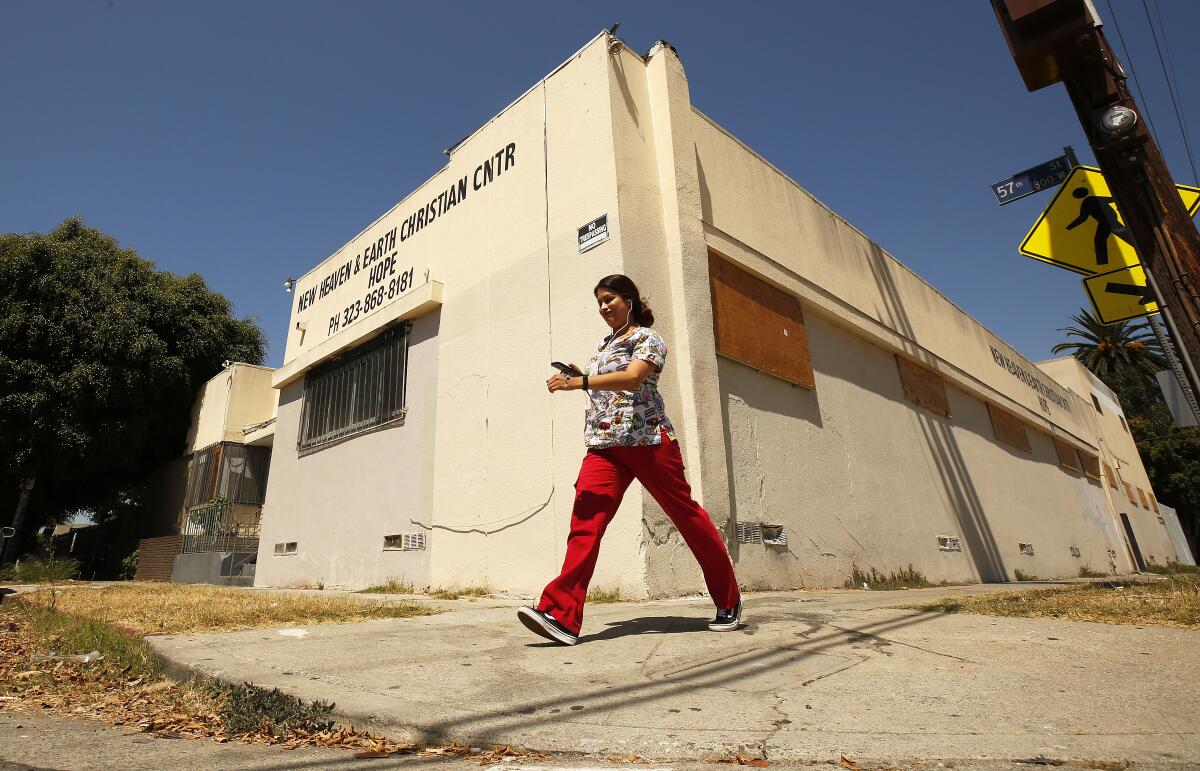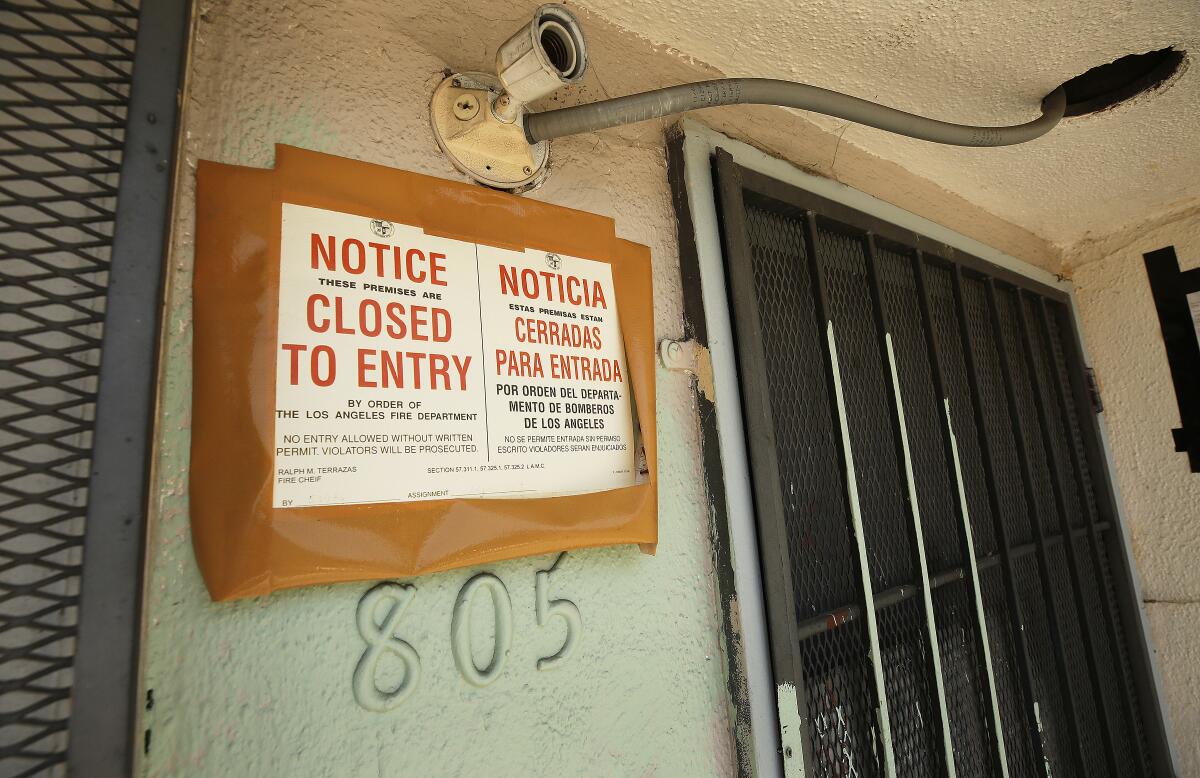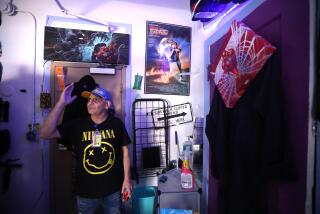They paid $800 a month to live without water or power in an abandoned L.A. church

- Share via
The illegally converted church in South Los Angeles had no gas, water or electricity when Amelda Glaspie moved in.
She and about 40 other tenants shared two kitchens, where roaches crawled among the dirty dishes and rotten food left in half a dozen refrigerators. Every day, Glaspie said, residents carted water from a nearby building in buckets to flush the toilets.
Paying $800 a month, she and her husband lived in a cramped bedroom until late June 2018, when LAPD officers ordered everyone to evacuate. A criminal complaint filed by the city in December said the garbage at 805 W. 57th St. was a breeding ground for rodents, bedbugs, fleas, lice, mosquitoes and other vermin.
Despite the conditions, some residents didn’t want to leave. Glaspie said they felt they had nowhere to go.

Although the living situation at the squalid building was extreme, it is far from unique in a county racked by a shortage of affordable housing where nearly 59,000 people are homeless.
The issue of people residing in unapproved spaces became a focus of the housing crisis three years ago, after 36 people died in the Ghost Ship warehouse fire in Oakland. That prompted crackdowns across the state and the closure of similarly converted warehouses.
Los Angeles Department of Building and Safety officials said such illegal housing often goes undetected until complaints are filed. But on the ground, it’s a different story.
Edna Monroy, director of outreach at the community organizing nonprofit SAJE, said she has seen people living in illegally converted garages, commercial buildings and even tool sheds. There have been cases, she said, of landlords sexually harassing or threatening people with deportation to prevent them from reporting their situations to the city.
“We’re seeing older Victorian homes with attics and basements being illegally converted into units,” she said. “It’s not a surprise … we’re in a housing crisis.”
The old storefront church on West 57th Street serves as an example of the grim conditions those without enough money are willing to live with, as well as how difficult it can be for authorities to root out illegal dwellings.
Department of Building and Safety records show that the city received complaints about the property dating to 2016 and earlier. One February 2017 caller, who identified himself as a Los Angeles police sergeant, said it reminded him of the Ghost Ship.
“It appears to be a fire hazard…. This place needs to be inspected ASAP and most probably closed down before someone gets hurt,” the caller said.
Various agencies — including the Los Angeles city attorney’s office, the Fire Department and the Department of Building and Safety — eventually opened investigations into the property, according to officials.
“It was unsafe. I was starting to get tired because I’m not used to living like that,” Glaspie said. “But then you got to do what you got to do sometimes.”
When residents were given the opportunity to return to the building a few weeks after being evacuated to gather belongings, Glaspie said, she saw dead cats, mice and roaches. She left her possessions behind.
During the time she lived there, Glaspie said, she and her husband paid rent in cash to Maurice Hoffman and Jim Lee Shepherd, whom she described as the property owners. Their names appeared on the city’s June 28, 2018, criminal case alleging various county building code violations at 805 W. 57th St.
The defendants are listed as Hoffman, president of Creative Investment Group Inc., a real estate investment company based in Burbank that owns the South L.A. property; Carmelito “Karl” Vandenberg, an associate of the investment company; and Shepherd, president of New Heaven & Earth Christian Center of Hope Inc., who allegedly acted as the building manager.
According to the complaint, the defendants not only allowed people to stay in a building that was not permitted for residential use but also had failed to keep the property in good repair and free of rubbish and vermin.
In an August phone interview, Hoffman said the property had been sold and declined to comment further. Shepherd and Vandenberg could not be reached for comment.
“Prior to filing criminal charges, citations were issued by the enforcement agencies involved, and our office held two city attorney office hearings where they were advised of the violations and given additional time to comply, to no avail,” Rob Wilcox, director of community engagement and outreach at the city attorney’s office, said in a written statement.
All three men are scheduled to be arraigned in November, according to Wilcox and court records.
Several former tenants also have filed a civil lawsuit against Creative Investment Group and New Heaven & Earth Christian Center of Hope, citing negligence, emotional distress and retaliatory eviction. One plaintiff, Wendy Menendez, alleged her child had suffered lead poisoning because she was not allowed to move to a new room after she discovered toxic paint. The civil complaint described Shepherd as the building’s landlord.
An attorney for Creative Investment Group has denied all of the civil complaint’s allegations against Hoffman and the company.
Efforts to convert the 5,600-square-foot church building began in 2010, when the owners applied for permits to repair floorboards, erect drywall and replace broken windows, according to city records. By 2016, inspectors had launched an investigation, documenting alleged trash buildup along with illegal plumbing and electrical wiring. Those allegations were listed in the criminal and civil complaints.
After the building was evacuated, the windows were boarded up. Notices warned trespassers that they were subject to arrest.
Victor James, who works for the nonprofit Homeless Outreach Program Integrated Care System, said he was there when the building was cleared out and had tried to help residents, including Glaspie, find temporary housing.
“It was totally filthy, no one had cleaned anything, all of the trash was accumulated,” James said. “It looked like an outdoor homeless encampment that was inside.” In the last six months, he said, his program has helped residents move out of at least four similar housing situations.
The Department of Children and Family Services, the Los Angeles Homeless Services Authority and other agencies also have worked to relocate residents who once called West 57th Street home.
Nicole Logan, who had been living in the building for about a year, said that since the evacuation she has found herself wondering where she is going to sleep. The homeless agency helped move her into a motel for a few weeks and subsequently set her up in a shelter. Sometimes, the shelter doesn’t have space, so she occasionally spends nights at a park on East 120th Street and South Avalon Boulevard in South L.A.
She said she had moved to L.A. after losing her job as a hairdresser in Las Vegas but couldn’t find affordable housing. She had been staying in a motel for several weeks when a fellow bus passenger pointed her to the building on West 57th Street. At the time, it sounded like a good option. When she first got there, she said, the building was at least functioning.
“My room was pretty cool; utilities were on,” she said. “Slowly but surely everything kind of went downhill.”
Logan said she kept paying her $600 monthly rent even as, one by one, the water, power and gas were turned off.
Glaspie said she is happier now.
After leaving West 57th, she was placed for several weeks in a motel. She eventually found a federally subsidized one-bedroom apartment in South L.A. for which she pays $275 a month. Her new flat has a living room and kitchen, and she has purchased a small bed for her 8-year-old grandson, who sometimes stays over.
Glaspie said that her seven children had been worried about her but that everything is working out for the best.
“Now all my sons and kids, they’re happy I’m in a place,” Glaspie said. “They come by and give me little things. My daughter says she’s going to buy me a sofa and a table.”
She’s glad to have put the building on West 57th behind her.
“Something with that building, I don’t know what it was,” she said. “But as soon as I got away from that place and took a shower and washed off something and was able to just lay down and relax without hitting bugs and roaches, I felt a lot better.”
More to Read
Sign up for Essential California
The most important California stories and recommendations in your inbox every morning.
You may occasionally receive promotional content from the Los Angeles Times.











